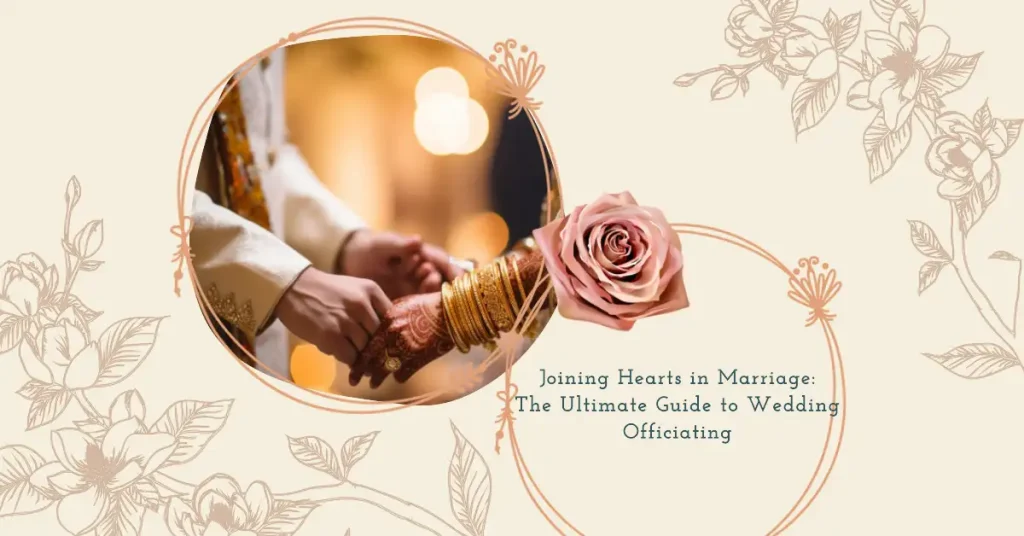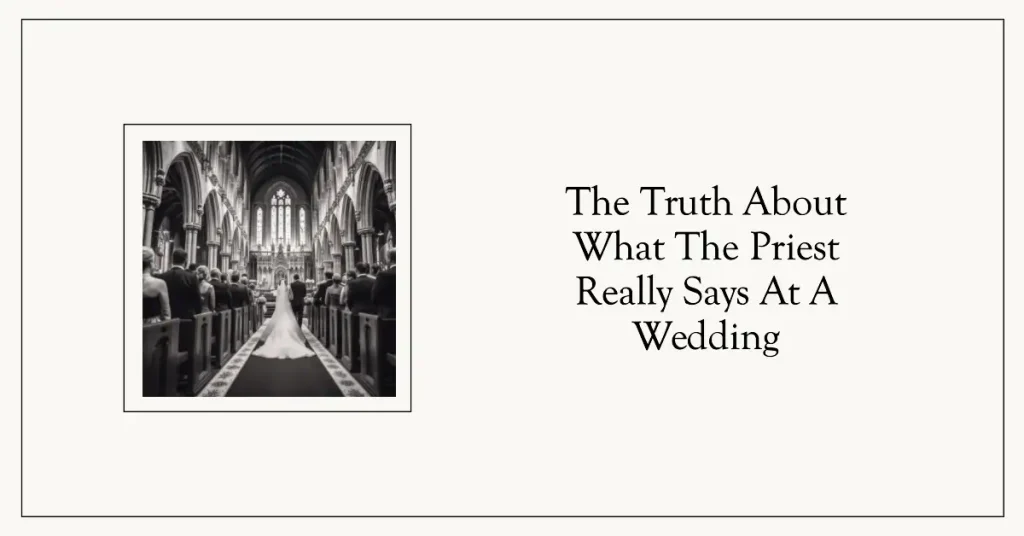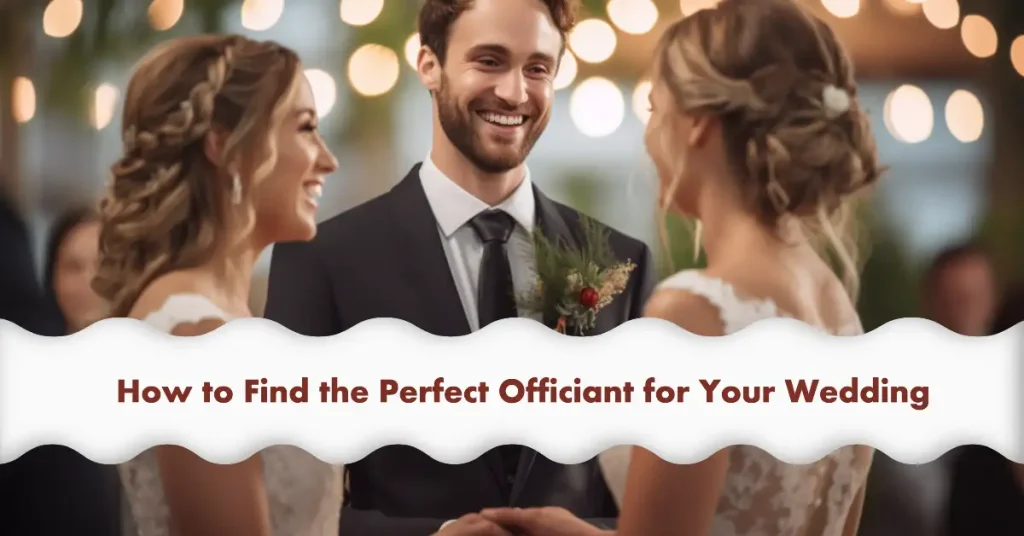Table of Contents
A typical wedding ceremony lasts approximately 20 to 30 minutes. However, the duration can vary depending on factors such as religious or cultural traditions and personal preferences.
A wedding ceremony is a momentous event that brings together two people in love, their families, and friends. As you plan this unforgettable occasion, you may wonder, “How long is a wedding ceremony?” In this article, we will explore various factors that can influence the duration of your wedding ceremony, helping you make an informed decision that suits your unique celebration.
Cultural and Religious Influences on Wedding Ceremony Length
Each culture and religion indeed have their unique customs and traditions when it comes to wedding ceremonies. Understanding these nuances will help you make well-informed decisions about the duration of your wedding ceremony. Let’s delve deeper into the varying lengths of wedding ceremonies in different cultural and religious contexts.
- Carter, Lisa (Author)
- English (Publication Language)
- 107 Pages - 04/06/2024 (Publication Date) - Independently published (Publisher)
Christian Wedding Ceremonies
- Catholic Weddings: A traditional Catholic wedding ceremony typically lasts between 45 minutes to an hour. This timeframe includes the processional, readings, exchange of vows, lighting of the unity candle, and the nuptial blessing. If the ceremony includes a full Mass, it may extend to 90 minutes or more.
- Protestant Weddings: Protestant ceremonies, such as those in Lutheran, Methodist, or Anglican traditions, generally take around 30 to 45 minutes. These ceremonies often feature hymns, readings, prayers, and the exchange of vows.
Jewish Wedding Ceremonies
A traditional Jewish wedding ceremony usually lasts between 30 to 45 minutes. Key components include the signing of the Ketubah (marriage contract), the Chuppah (wedding canopy) ceremony, the exchange of rings, the Seven Blessings, and the breaking of the glass.
Hindu Wedding Ceremonies
Hindu wedding ceremonies are known for their elaborate rituals and vibrant celebrations. Spanning several hours or even days, the main ceremony often lasts between 1.5 to 2 hours. Significant elements include the Jaimala (exchange of garlands), Kanyadaan (giving away the bride), Vivah Homa (sacred fire ritual), and Saptapadi (seven steps around the fire).
Muslim Wedding Ceremonies
Muslim wedding ceremonies, also known as Nikah, are relatively brief, usually lasting around 30 minutes to an hour. The ceremony consists of the signing of the marriage contract, a short sermon, and the exchange of vows and rings.
Buddhist Wedding Ceremonies
Buddhist wedding ceremonies are typically simple and can last between 30 minutes to an hour. The ceremony often involves blessings from monks, the recitation of prayers, and the offering of food and gifts to the monks.
Non-Denominational or Secular Wedding Ceremonies
Non-denominational or secular wedding ceremonies tend to be shorter, usually taking 20 to 30 minutes. These ceremonies often include personalized elements, such as readings, vows, and rituals that reflect the couple’s values and beliefs.

Personalizing Your Ceremony: How Your Choices Affect Duration
Incorporating personal touches into your wedding ceremony allows you and your partner to create a unique and memorable experience that reflects your love story. However, it’s essential to consider how these personalized elements may impact the ceremony’s duration. Let’s explore various ways to personalize your ceremony and how they may affect the timeline.
Readings
Adding readings to your ceremony can provide meaningful moments and showcase your values, beliefs, or favorite literature. You may choose to include passages from religious texts, poetry, or excerpts from books that hold a special place in your hearts. Each reading typically lasts around 2 to 5 minutes, so be sure to consider how many readings you’d like to include and allocate sufficient time for each.
Musical Performances
Live music can elevate the atmosphere of your wedding ceremony and create unforgettable moments. You may choose to have a soloist, instrumentalist, or choir perform during the processional, recessional, or at various points throughout the ceremony. Depending on the number and length of musical performances, this could add anywhere from 5 to 20 minutes to your ceremony.
Unity Ceremonies
Unity ceremonies are symbolic rituals that represent the joining of two lives. Popular options include the unity candle ceremony, sand ceremony, or handfasting. These rituals typically take 5 to 10 minutes and can add a personal and intimate touch to your wedding ceremony.
Personal Vows
Writing your own vows allows you and your partner to express your love and commitment in your own words. Personal vows can vary in length, but it’s important to keep them concise to maintain the ceremony’s flow. Plan for each set of vows to take around 2 to 5 minutes.
Honoring Loved Ones
Incorporating moments to honor loved ones who have passed away or cannot be present at your ceremony can add a sentimental touch. This may involve lighting a memorial candle, displaying photos, or including their names in a reading. Depending on the chosen method, this could add an additional 2 to 5 minutes to your ceremony.
Cultural or Family Traditions
Integrating cultural or family traditions into your wedding ceremony can create a sense of connection and heritage. This may include specific rituals, dances, or blessings that are significant to your background. The duration of these elements can vary widely, so be sure to factor them into your timeline.

The Size of Your Wedding Party
The size of your wedding party can indeed have a significant influence on the duration of your wedding ceremony. A larger wedding party may require additional time for various aspects of the event, from the processional to the recessional. Let’s examine how the size of your wedding party can affect different stages of your ceremony and potential ways to manage these factors.
The Processional
The processional marks the beginning of the wedding ceremony and involves the entrance of the wedding party, including the officiant, groom, bridesmaids, groomsmen, flower girls, and ring bearers. A larger wedding party will require more time for the processional, as each person or pair of individuals takes their place at the altar. To ensure a smooth and timely processional, it’s important to rehearse the order of entrance and the walking pace.
Seating Arrangements
The size of your wedding party may also impact the time required for seating arrangements. Larger wedding parties may need additional time to ensure everyone is seated appropriately, both during the ceremony and at the reception. Careful planning and clear communication with your wedding planner and venue coordinator can help streamline the seating process and reduce delays.
Exchanging Vows and Rings
The exchange of vows and rings typically occurs in the presence of the entire wedding party. A larger wedding party may mean more people need to be in position and ready for these pivotal moments. Ensuring that everyone in the wedding party knows their role and is prepared for the exchange can help keep the ceremony running smoothly.
The Recessional
At the end of the ceremony, the wedding party exits the venue in the recessional. Similar to the processional, a larger wedding party may require additional time for the recessional. To avoid delays, it’s essential to rehearse the order of exit and maintain a steady walking pace.
Photography
A larger wedding party can also impact the time required for wedding photos, both before and after the ceremony. It’s crucial to allocate enough time for group photos, ensuring that everyone is present and organized for each shot. Working closely with your photographer and creating a detailed shot list can help manage the photography timeline effectively.

Structuring the Wedding Ceremony: Order of Events
The order of events during your wedding ceremony plays a crucial role in ensuring a smooth and enjoyable experience for you and your guests. Carefully structuring the ceremony will help you create a seamless flow, allowing each part of the event to unfold effortlessly. Let’s delve deeper into the various elements that make up a typical wedding ceremony and how to arrange them for optimal flow and timing.
Prelude
The prelude is the period before the ceremony when guests begin to arrive and find their seats. This usually starts around 20 to 30 minutes before the ceremony’s official start time. Soft music is often played in the background to set the tone and atmosphere.
Processional
The order of the processional varies depending on cultural and personal preferences, but a typical sequence includes the officiant, groom, bridesmaids, groomsmen, flower girl, and ring bearer. The bride traditionally makes her entrance last, accompanied by her escort.
Welcome and Opening Remarks
Once everyone is in place, the officiant welcomes the guests and offers opening remarks or a prayer. This sets the tone for the ceremony and acknowledges the significance of the occasion.
Readings and Musical Performances
Readings and musical performances can be interspersed throughout the ceremony. You may choose to include religious or secular readings, as well as soloists, instrumentalists, or choirs to perform at specific moments during the ceremony. Coordinate with your officiant and musicians to ensure a seamless integration of these elements.
Exchange of Vows
The exchange of vows is the heart of the wedding ceremony. The couple expresses their love and commitment to one another, either through traditional vows or personalized promises. The officiant typically guides this process and prompts the couple to repeat the vows after them.
Ring Exchange
Following the vows, the couple exchanges wedding rings, symbolizing their eternal bond. The officiant usually offers a blessing or a few words about the significance of the rings before the couple places them on each other’s fingers.
Unity Ceremony (Optional)
If you choose to include a unity ceremony, this is usually incorporated after the ring exchange. This symbolic ritual represents the joining of two lives and can take various forms, such as lighting a unity candle, combining sand, or performing a handfasting.
Pronouncement and Kiss
After the couple has exchanged vows and rings, the officiant pronounces them as married and invites them to share their first kiss as a married couple. This is often followed by applause and cheers from the guests.
Closing Remarks and Blessing
The officiant offers closing remarks, which may include a final prayer or blessing, and thanks the guests for their attendance. This marks the end of the official ceremony.
Recessional
The wedding party exits the venue in a specific order, starting with the newlyweds, followed by the bridesmaids and groomsmen, flower girl, ring bearer, and finally the officiant. Music is often played during the recessional, signaling the transition to the post-ceremony celebrations.

Time Management: Ensuring a Smooth and Efficient Ceremony
Time management plays a crucial role in the success of your wedding ceremony, ensuring that each component unfolds seamlessly while adhering to your desired timeline. By allocating sufficient time for every aspect of the ceremony, from pre-ceremony preparations to post-ceremony celebrations, you can create a memorable and enjoyable experience for everyone involved. Let’s explore some key strategies for effective time management during your wedding ceremony.
Create a Detailed Schedule
A comprehensive schedule serves as a roadmap for your wedding day, outlining the timing and sequence of each event. Work closely with your wedding planner, officiant, and venue coordinator to develop a realistic timeline that takes into account the duration of each ceremony component, as well as any transitions or breaks.
Rehearse the Ceremony
Holding a rehearsal is essential for ensuring that everyone involved in the ceremony is familiar with their roles and the order of events. This helps to minimize potential delays and ensures that each part of the ceremony flows smoothly. Schedule your rehearsal a day or two before the wedding, allowing ample time for adjustments or last-minute changes.
Allocate Time for Setup and Breakdown
Don’t forget to allocate time for setting up and breaking down the ceremony space. This includes arranging chairs, decorating the altar, and preparing any audiovisual equipment. Work with your venue coordinator to determine the best time for setup, allowing for any necessary adjustments or touch-ups before guests arrive.
Plan for Buffer Time
Incorporate buffer time into your schedule to accommodate any unforeseen delays or last-minute changes. This may include extra time for guest arrival, unexpected traffic, or wardrobe adjustments. By building in some flexibility, you can minimize stress and ensure that your ceremony runs as smoothly as possible.
Communicate the Timeline to Key Participants
Clear communication is crucial for effective time management. Share your detailed schedule with key participants, including your wedding party, family members, officiant, and vendors. This ensures that everyone is aware of the timeline and can prepare accordingly.
Designate a Timekeeper
Appoint a trusted friend, family member, or your wedding planner as the official timekeeper for your wedding ceremony. This person will be responsible for keeping the event on track and ensuring that each component adheres to the established timeline. The timekeeper can provide gentle reminders or cues to help maintain the flow of the ceremony.
Prepare for Post-Ceremony Activities
Finally, allocate sufficient time for post-ceremony activities, such as photography, cocktail hour, and the reception. Work with your photographer to develop a shot list and schedule, ensuring that you capture all the essential moments without delaying the celebrations.
Conclusion: How Long is a Wedding Ceremony?
Ultimately, the length of your wedding ceremony depends on your personal preferences, cultural or religious background, and the specific elements you choose to incorporate. By considering these factors and working closely with your wedding professionals, you can create a ceremony that is not only meaningful but also the perfect duration for you and your guests. Remember, this is your special day, and the focus should be on celebrating the love between you and your partner.
FAQs
Q: Can a couple customize the length of their wedding ceremony?
A: Yes, absolutely! Couples can work with their officiant or wedding planner to customize the length of their ceremony to fit their preferences and needs. For example, they may choose to add or remove certain elements or shorten or lengthen readings.
Q: How can a couple ensure their wedding ceremony stays on schedule?
A: One way to ensure the ceremony stays on schedule is to have a detailed schedule or timeline in place ahead of time. The couple and their wedding planner or coordinator can work together to create a timeline that outlines each part of the ceremony and how long it should take. It’s also a good idea to communicate this timeline with the wedding party and vendors so that everyone is on the same page.
Q: Is it okay for a wedding ceremony to be shorter or longer than average?
A: Absolutely! There’s no “right” or “wrong” length for a wedding ceremony – it’s all about what works for the couple and their guests. Some couples may prefer a shorter, more streamlined ceremony, while others may want to include many meaningful rituals or traditions that make the ceremony longer. Ultimately, it’s up to the couple to decide what’s best for them.
Q: What are some ways to make a wedding ceremony shorter?
A: Couples can make their wedding ceremony shorter by choosing to exclude certain elements or rituals, such as unity candles or sand ceremonies, and by keeping readings and speeches short and to the point. They can also work with their officiant to create a more streamlined ceremony.
Q: What are some ways to make a wedding ceremony longer?
A: Couples can make their wedding ceremony longer by including more readings, musical performances, or rituals, such as handfasting or jumping the broom. They can also choose to have a longer sermon or message from their officiant.
Q: Can the length of a wedding ceremony impact the rest of the wedding day schedule?
A: Yes, the length of a wedding ceremony can impact the rest of the wedding day schedule. If the ceremony runs longer than expected, it can delay the start of the reception or other events that follow the ceremony. This is why it’s important to have a timeline in place and to communicate it with all vendors and wedding party members.
Q: Are there any time restrictions on wedding ceremonies?
A: The length of a wedding ceremony is typically not restricted by time, but there may be restrictions on the time of day when a ceremony can take place. For example, some religious venues may only allow ceremonies during certain hours, or outdoor ceremonies may need to end before sunset due to lighting or noise restrictions.
Q: How can a couple ensure their guests are comfortable during a longer ceremony?
A: Couples can help their guests stay comfortable during a longer ceremony by providing amenities such as shade, seating, and refreshments. They can also consider adding interactive elements, such as having guests participate in a unity ritual or asking them to share a personal story or memory.
Q: Can the length of a wedding ceremony affect the cost?
A: The length of a wedding ceremony typically does not affect the cost, as officiants and wedding venues generally charge a flat fee. However, couples should factor in the time it takes to set up and break down the ceremony space when creating their wedding budget.
Q: Can a couple have a short ceremony followed by a longer reception?
A: Yes, absolutely! Many couples choose to have a shorter ceremony followed by a longer reception to allow for more time to celebrate with their guests. This is a great way to keep the ceremony intimate and meaningful while still having a fun and lively party.
Q: Is it possible to have a wedding ceremony that is too long?
A: Yes, it is possible to have a wedding ceremony that is too long. If a ceremony runs too long, guests may become restless or bored, which can detract from the overall experience. This is why it’s important to balance meaningful elements with brevity and to keep guests’ comfort in mind.
Q: How can a couple communicate the expected length of their ceremony to their guests?
A: Couples can communicate the expected length of their ceremony to their guests by including a timeline or program in their wedding invitations or on their wedding website. They can also ask their officiant to provide a rough estimate of how long the ceremony will last.
Key Takeaways
- The duration of a wedding ceremony can vary depending on factors such as cultural and religious traditions, personal preferences, and the elements included.
- Different religious and cultural wedding ceremonies have varying lengths. For example, Catholic ceremonies typically last between 45 minutes to an hour, while Hindu ceremonies can span several hours or even days.
- Non-denominational or secular ceremonies tend to be shorter, usually taking around 20 to 30 minutes.
- Personalizing the ceremony with elements like readings, musical performances, unity ceremonies, personal vows, and honoring loved ones can impact the duration.
- The size of the wedding party can affect the ceremony’s length, particularly during the processional, seating arrangements, exchanging vows and rings, and the recessional.
- Structuring the ceremony with a well-organized order of events, such as the prelude, processional, welcome and opening remarks, readings and musical performances, exchange of vows, ring exchange, unity ceremony (optional), pronouncement and kiss, closing remarks and blessing, and recessional, helps create a seamless flow.
- Effective time management, including creating a detailed schedule, rehearsing the ceremony, allocating time for setup and breakdown, planning for buffer time, communicating the timeline to key participants, designating a timekeeper, and preparing for post-ceremony activities, ensures a smooth and efficient ceremony.
- Couples have the flexibility to customize the length of their ceremony based on their preferences and needs, and there are no strict rules regarding the ideal length.
- Communication with guests about the expected length of the ceremony can be done through wedding invitations, wedding websites, or including a timeline or program.
- It is important to balance meaningful elements with brevity and consider guests’ comfort to avoid a ceremony that is too long.
COPYRIGHT NOTICE
Please be advised that all images, designs, and creative content on this page are the exclusive property of TheIDoGuide.com and are protected under international copyright laws. The images may not be reproduced, copied, transmitted or manipulated without the written permission of TheIDoGuide.com.
Unauthorized use, distribution, display, or creation of derivative works of any images contained on this site, is strictly prohibited and can lead to legal penalties. We actively monitor for, and enforce, our copyright interests.
If you wish to use any of our images, kindly contact us to seek permission. Respect of copyright is not merely a legal requirement but also an acknowledgement and support of the hard work and creativity that goes into producing them.
Thank you for your understanding and cooperation.
© 2023, TheIDoGuide.com. All Rights Reserved.






